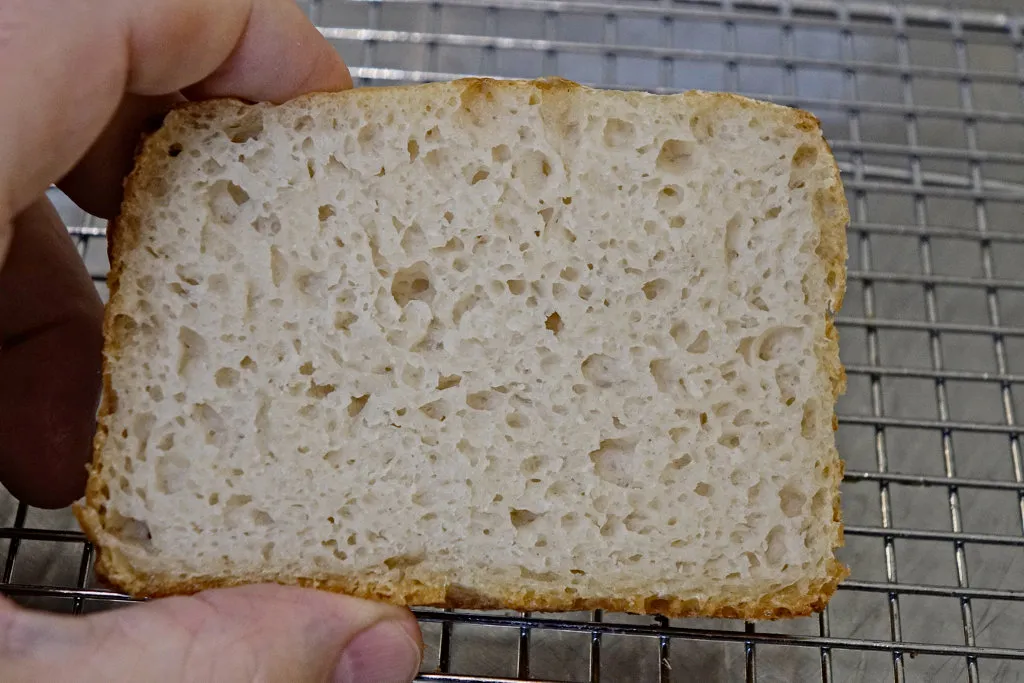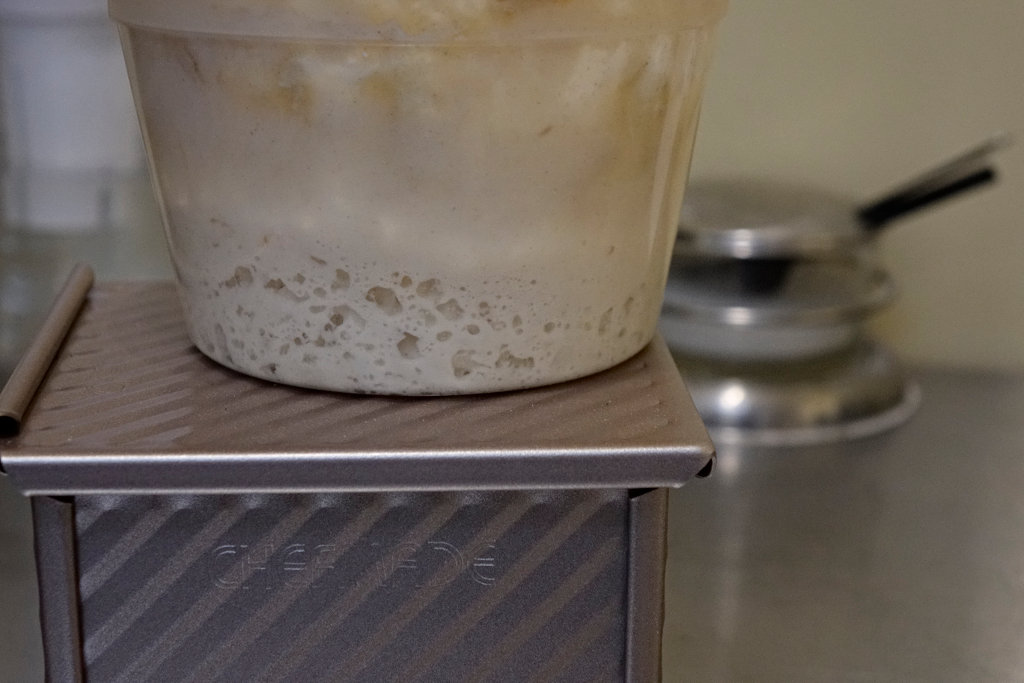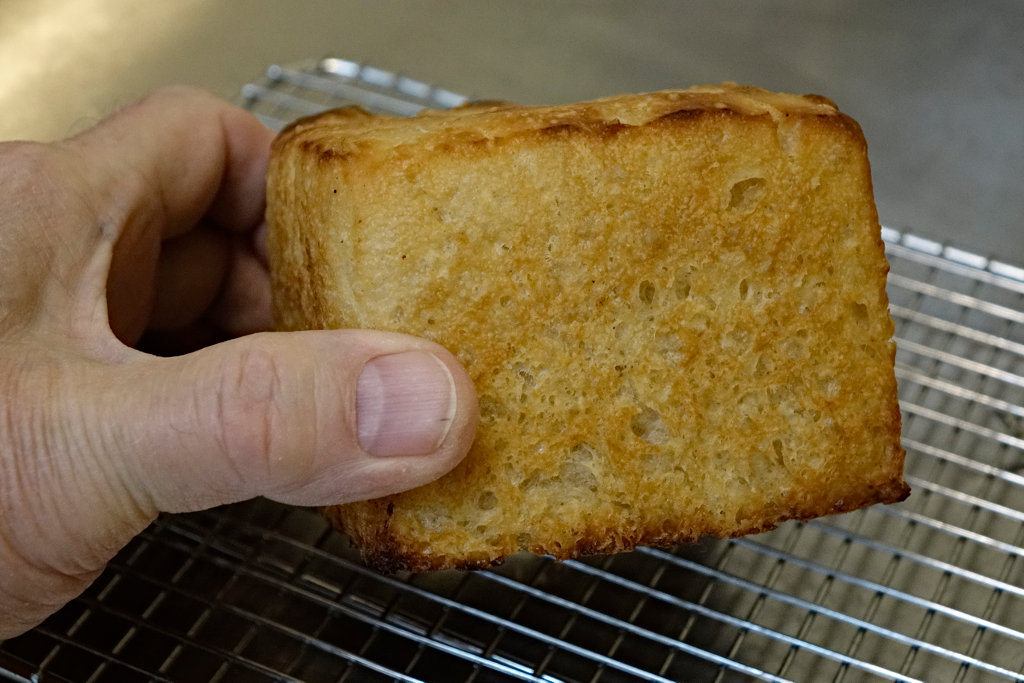
You know that bubbly, lacy appearance when you look at a well-fermented starter through the side of its container? I've often wondered if that structure could be captured by baking it, and what the result would taste like. Now that I've got my new 4 X 4 X 4 Pullman pan (excuse me, "toast box"), I decided to try it out.
My standard starter these days is 90% hydration, 2% salt, bread flour. I refresh it just before bed and it will typically be ready to use around 10 - 12 hours later. Then it slowly goes downhill until the next refresh. I use a translucent deli container for the starter. In the morning I refreshed the starter 1:5:4.5 starter:flour:water, and in the late evening I took 30g and refreshed it in the same ratio, meaning 150g of flour. I took 5g of the remaining starter and refreshed it with the same ratio, putting it back into the deli container.** The large portion I put into the buttered Pullman pan and covered it with the lid. This was right at midnight.
** the container is getting a little gross with too much dried out old starter. It's just about time to move to a new one.
Using this method I could use the deli jar starter to gauge how developed the ferment was, much like an aliquot jar.
By 11 AM the next morning the starter in the deli container was very bubbly and lacy and may have started to sink a bit. In the Pullman the dough/starter had risen somewhere between 2/3 and 3/4 of the way up. Sadly, I didn't think to make a measurement. Time to bake!
I baked lid on at 400 deg F/204C for 35 minutes in my countertop oven. By that time the loaf was baked but the top looked pale and anemic since it had not risen up to contact the lid. In fact it hadn't risen at all but looked like it had sunk a bit, down to about 2/3 of the pan height. I suppose the dough was overproofed, though it doesn't look sunken and the pores are still large. To get some more color, I took the loaf out of the pan and baked it upright at 425 deg F for another 6 minutes.
Even with the subsidence it looks like those lacy bubbles did get baked in. The crumb is obviously very full of large size holes. The crust is thin and crispy with a good flavor. The crumb is a little soft and sponge-like and it has a stronger, slightly buttery flavor than white loaves usually have. I didn't notice any tang, which surprised me.


I suppose you could call this a 100% preformated flour loaf. Or you could say it's the ultimate porridge loaf. It illustrates how flexible the use of a loaf pan can be (especially a Pullman pan). Dough too wet and sticky to shape? Scrape it right into the buttered pan. Let it bulk ferment until well along then bake. Dough stiff? After bulk ferment, shape into a log or several balls, then place into the pan. Or anything in between. It's hard to miss. They're all good.
TomP
- tpassin's Blog
- Log in or register to post comments
Wow! Great experiment, if I may call it so. I definitely like the result. You made me curious, will definitely try the same with my starter.
Regarding taste, I assume the salt slowed down the acid production.
I think that's the case about the salt. The acid and tang always seem to take longer to build up.
c
I’ve never put salt in my starter and it’s fully risen in approx 4° so I don’t leave it overnight.
What I do for my pizza dough is make a huge mount of flour/water/ large glop stored levain( approx 100% hydration I don’t measure) . It bubbles up in a few hours and I cover it and store in the fridge for 4-5 days. I stir it down and use it as my starter/pff. I add EVOO,salt, non- diastatic malt enough water and flour to make a very soft dough. Then proceed.
When making the Challah which for decades was an ADY formula I simply substitute 2c of the active pff/ starter for 1c each flour/water from my original 1970’s recipe. I add 2 tsp of ADY and proceed this makes 7# of dough .
Also there is no kneading for either of these. I beat , add rest of flour fold til thoroughly wet . Rest. Do bowl folds 2x q15 min. Dump out floured counter and do 2 gentle laminations . Bulk rise and shape rise bake. So fast and easy.
It’s wonderful the new ways everyone is evolving techniques! c
Someone mentioned recently the Mandela Effect. That's what I felt when I saw this thread-- that you had already done this, or something similar.
Anyhoo, AI told me that although baking the starter kills bacteria and yeast, mixing a piece of it with flour and water will revive it and create a new starter in a couple days. That seems contradictory to me. Like Schrodinger's cat, it is both alive and dead.
I'm fairly sure I haven't baked starter before, although I've done a lot of weird experiments. As for reviving a cooked starter, methinks it's just creating a new starter from scratch. Residual acidity in the baked starter would speed up the process.
What I have done, long ago, was to bake some flour and try to create a starter with it. That failed - no activity ever showed up. A side-by-side control using the same flour (but unbaked) turned into a starter following a normal schedule.
...similar before. Still, looks delicious!
I agree. Spend the same amount of time 'reviving' a starter as it takes to make a new starter then one has made a new starter. I don't believe all the hype when we hear of Egyptologists finding some 3000 year old starter, then spending 2 weeks reviving it and reporting that they have made sourdough from the original 3000 year old yeast.
Same goes for dried starter. In fact flour is dried starter!
Think about that - the old experiment that is. It should be obvious. Enjoy!
Baked starter looks delicious.
If one over ferments a dough and it becomes unmanageable (i.e. turns to starter) then throw it in a loaf pan and bake it anyway. If it turns out anything like this it'll be delicious.
I expected to read a tale of woe where all of the starter went into a batch of bread, with nine being saved for future use. Been there, done that.
So happy to hear that wasn’t the case and that you have a lovely bread, instead.
Paul
Lovely outcome Tom, and excellent looking toast.
I've tried similar in the past, but don't recall having as successful an outcome as you had here!
-Jon
That turned out extremely well Tom. 100% prefermented flour loaf, interesting that you noticed buttery note in it. Did you butter the pan, is that where the buttery notes are from?
Benny
I did butter the pan, but it seemed to me that the crumb had a faint buttery note of its own.